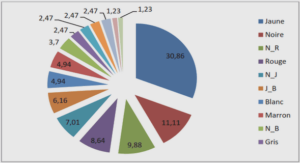Cinq essais sur les jeux d’oligopoles coopératifs
The cooperative approach of oligopoly situations
A central question in oligopoly theory is the existence of collusive behaviors between firms. The main reason for which economists try to understand this phenomenon is that the formation of cartels impacts on both consumers’ and producers’ surplus, and so affects total welfare. In economic welfare analysis, it is a well-established and old idea that monopoly power can negatively affect social welfare. In his classic, The Wealth of Nations, Smith (1776) writes on both collusion between rival firms and on the exercise of monopoly power: People of the same trade seldom meet together, even for merriment or diversion, but the conversation ends in a conspiracy against the public, or in some contrivance to raise prices. The monopolists, by keeping the market constantly understocked, by never fully supplying the effectual demand, sell their commodities much above the natural price. At the end of the 19th century, as a reaction to the formation of trusts in the United States, a consensus emerged on the necessity to maintain competition in industries. This led to the establishment of the first anti-trust law in the United States, the 1890 Sherman Act. While Section 1 of the act prohibited contracts, combinations and conspiracies “in restraint of trade”, Section 2 of the act made illegal monopolization or any attempt to monopolize. This legislation permitted the United States government to sue and dismantle two famous trusts, the Standard Oil Company and American Tobacco. Afterwards, other anti-trust laws were established in the United States as the Clayton and Federal Trade Commission Acts in 1914. 1 2 Chapter 1 In European Union, modern competition policy is principally established by the Treaty of the European Communities. It pays attention to both horizontal and vertical agreements (Article 81), abuse of dominant position (Article 82) and the regulation of mergers. A horizontal (vertical) agreement is an agreement among competitors on the same level (different levels) of production or distribution. Abuse of dominant position occurs when a firm uses a dominant position in the market to impede the maintenance of effective competition. Motta (2004) defines competition policy as: “the set of policies and laws which ensure that competition in the marketplace is not restricted in such a way as to reduce economic welfare.” In this definition two elements should be underlined. The first is that firms may restrict competition in a way which is not necessarily detrimental. This is the case for some horizontal agreements where firms collaborate in research and development activities. By means of cross-licensing or patent pooling, firms can share research and development costs/results in order to reduce sales prices. This is in line with D’Aspremont and Jacquemin (1988) who show that cooperative behavior in research and development activities can positively affect economic welfare by generating spillover effects in industries having a few firms. This is also the case for many vertical restraints (vertical agreements) between a manufacturer and a retailer such as non-linear pricing (the price is composed of two parts: a lump-sum fee as well as a per-unit charge), quantity fixing (the retailer cannot buy less or more than a certain number of units fixed by the manufacturer) and exclusivity clauses (for instance, an exclusive territory clause specifies that there is only one retailer who sell a brand in a certain geographical area). The second is that economic welfare is the objective that competition policy pursues. Economic welfare is the standard concept which measures how well an industry performs. Economic welfare is given by the total surplus, i.e. the sum of consumer surplus and producer surplus. The surplus of a consumer is defined as the difference between the consumer’s valuation for the good and the effective price for which he has to pay for it. Consumer surplus is the sum of the surplus of all consumers. The surplus of a producer is the profit it makes by selling the good. Producer surplus is the sum of profits of all producers in the industry. Although cooperation on research and development activities may have beneficial welfare effects, both in the United States and European Union, many other horizontal agreements such as agreements on sales prices and division of the market shares are considered as negative for welfare. By keeping in mind these considerations, the study of cooperative oligopoly games is relevant insofar as it permits to establish the conditions under which a horizontal agreement on sales prices is likely to be stable, i.e. not contested by any firm, in an oligopolistic market, which is one of the main preoccupations of competition authorities. Precisely, this thesis tries to answer the question on the existence of stable horizontal agreements on sales prices from two angles: quantity competition (Part I) and price competition (Part II). While Part I deals with quantity competition where firms can indirectly control sales prices by engaging on the quantity produced, Part II analyzes price competition where firms can directly manipulate sales prices by agreeing on the prices charged. In both competition types, competitors form a cartel (coalition) in which they cooperate and agree on sales prices. Thus, the existence of horizontal agreements on sales prices is related to the problem of the formation of coalitions.
A review of game theory approaches on cooperation in oligopoly situations
Oligopoly theory deals with competition models which can be divided into two parts, i.e. the quantity competition (Cournot 1838) and the price competition (Bertrand 1883). For the quantity competition, Stackelberg (1934) incorporates the idea of commitment by proposing a leader-follower model. For each of these three oligopoly situations, some early works have already investigated cooperation between firms by means of both non-cooperative and cooperative oligopoly games. As regards Cournot oligopoly situations, Salant et al. (1983) analyze the equilibrium distribution of outputs among the cartels and show that mergers may reduce cartel members’ profits.
A review of game theory approaches on cooperation in oligopoly situations
Norde et al. (2002) distinguish two different types of oligopoly situations, namely those with transferable technologies and those without transferable technologies. In the first type, a group of firms produces according to the cheapest technology used by the cartel members, whereas such a transfer of technologies is not possible for the second type. For Cournot oligopoly situations with or without transferable technologies, Zhao (1999a,b) shows that the α and β-characteristic functions are equal, and so the same set of Cournot oligopoly TU-games is associated with these two characteristic functions. When technologies are transferable, Zhao (1999a) provides a necessary and sufficient condition in order to establish the convexity property in case the inverse demand and cost functions are linear. This property means that there are strong incentives to form the grand coalition insofar as the marginal contribution of a firm to some coalition increases if the coalition which it joins becomes larger. Although these games may fail to be convex in general, Norde et al. (2002) show they are nevertheless totally balanced which ensures the non-emptiness of the core. When technologies are not transferable, Zhao (1999b) proves that the core is non-empty if any individual strategy set is compact and convex and any individual profit function is continuous and concave. More generally, by using a technical proof inspired from Scarf (1971), Zhao shows that the core is nonempty for general TU-games in which any individual strategy set is compact and convex, any individual utility function is continuous and concave, and the strong separability condition is satisfied. This latter condition requires that the utility function of a coalition and any of its members’ individual utility functions have the same minimizers. Zhao proves that Cournot oligopoly TU-games satisfy this latter condition. Furthermore, Norde et al. (2002) show that these games are convex in case the inverse demand and cost functions are linear, and Driessen and Meinhardt (2005) provide economically meaningful sufficient conditions in order to guarantee the convexity property in a more general case. Concerning Stackelberg oligopoly situations, in case there are a single leader and multiple followers in a quantity competition, Sherali et al. (1983) study strategic Stackelberg oligopoly games and prove the existence and uniqueness of the Nash equilibrium in case the inverse demand function is twice differentiable, strictly decreasing and satisfies for any output X ∈ R+, p 0 (X) + Xp00(X) ≤ 0 (Sherali et al. provide an economic interpretation of this condition), and the individual cost functions are twice differentiable and convex. In particular, they show that the convexity of followers’ reaction functions with respect to leader’s output is crucial for the uniqueness of the Nash equilibrium. For general TU-games, Marini and Currarini (2003) associate a two-stage structure with the γ-characteristic function. In this temporal sequence, any deviating 10 Chapter 1 coalition possesses a first-mover advantage by acting as a leader while outsiders play their individual best reply strategies as followers. By assuming that any player’s individual utility function is twice differentiable and strictly concave on its individual strategy set, they prove that if the players and externalities are symmetric (the players have identical individual utility functions and strategy sets, and externalities are either positive or negative) and the game has strategic complementarities, then the equal division solution belongs to the core. They apply their result to three economic models. First, they consider a quantity competition in which strategies are substitutes and show that the core associated with the two-stage game is non-empty. Then, they deal with a price competition and prove that for lower degrees of product differentiation, the core associated with the two-stage game becomes increasingly smaller than the core associated with the simultaneous game. Finally, they study an economy with two commodities, a public good and a private good, and show that the core associated with the two-stage game is empty.
1 Introduction |






